- Clone
- 20/70 (See other available formats)
- Regulatory Status
- RUO
- Other Names
- C5a ligand, C5a anaphylatoxin receptor, C5AR, C5R1, C5AR1
- Isotype
- Rat IgG2b, κ
- Ave. Rating
- Submit a Review
- Product Citations
- publications
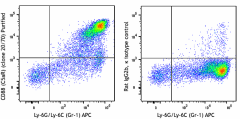
-

C57BL/6 mouse bone marrow granulocytes stained with Ly-6G/Ly-6C (Gr-1) APC and CD88 (C5aR) (clone 20/70) purified (left) or rat IgG2b, κ purified isotype ctrl (right) followed by anti-rat IgG FITC.
| Cat # | Size | Price | Quantity Check Availability | Save | ||
|---|---|---|---|---|---|---|
| 135802 | 100 µg | 118€ | ||||
CD88 is a single chain protein with seven membrane-spanning regions and a molecular weight of 43 kD. CD88 is expressed by neutrophils, eosinophils, and monocytes. There have been reports of CD88 expression in non-immune cells such as glial cells, cerebellar granule cells, cardiomyocytes, and vascular endothelial cells. CD88 is coupled to heterotrimeric G proteins such as Gi, and after C5a binding, the signal transduced by CD88 results in the activation of PLCβ, PI-3 kinase, and PLA2, among other molecules, resulting in chemotaxis, granule enzyme release, and superoxide anion production.
Product DetailsProduct Details
- Verified Reactivity
- Mouse
- Antibody Type
- Monoclonal
- Host Species
- Rat
- Immunogen
- mC5aR transfected cells
- Formulation
- Phosphate-buffered solution, pH 7.2, containing 0.09% sodium azide.
- Preparation
- The antibody was purified by affinity chromatography.
- Concentration
- 0.5 mg/ml
- Storage & Handling
- The antibody solution should be stored undiluted between 2°C and 8°C.
- Application
-
FC - Quality tested
- Recommended Usage
-
Each lot of this antibody is quality control tested by immunofluorescent staining with flow cytometric analysis. For flow cytometric staining, the suggested use of this reagent is ≤ 0.25 µg per 106 cells in 100 µl volume. It is recommended that the reagent be titrated for optimal performance for each application.
- Application Notes
-
Additional reported applications for the relevant formats include: blocking of C5a binding.
-
Application References
(PubMed link indicates BioLegend citation) -
- Godau J, et al. 2004. J. Immunol. 173:3437.
- Shushakova N, et al. 2002. J. Clin. Invest. 110:1823.
- Kim SH, et al. 2013. Int Immunol. 25:623. PubMed
- Product Citations
-
- RRID
-
AB_1953295 (BioLegend Cat. No. 135802)
Antigen Details
- Structure
- Single chain protein with seven membrane-spanning regions, 43 kD.
- Distribution
-
Neutrophils, eosinophils, monocytes, glial cells, cerebellar granule cells, cardiomyocytes, and vascular endothelial cells.
- Function
- After C5a binding, the CD88 signal results in chemotaxis, granule enzyme release and superoxide anion production.
- Interaction
- CD88 is coupled to heterotrimeric G proteins such as Gi, The signal transduced by CD88 results in the activation of PLCβ, PI-3 kinase, and PLA2, among other molecules.
- Bioactivity
- Chemotaxis, degranulation.
- Cell Type
- Dendritic cells, Endothelial cells, Eosinophils, Monocytes, Neutrophils
- Biology Area
- Cell Biology, Cell Motility/Cytoskeleton/Structure, Immunology, Innate Immunity, Neuroinflammation, Neuroscience
- Molecular Family
- CD Molecules
- Antigen References
-
1. Schraufstatter IU, et al. 2009. J. Immunol. 182:3827.
2. Ippel JH, et al. 2009. J. Biol. Chem. 284:12363.
3. Monk PN, et al. 2007. Br. J. Pharmacol. 152:429.
4. Griffin RS, et al. 2007. J. Neurosci. 27:8699.
5. Lee H, et al. 2006. Nat. Biotechnol. 24:1279.
6. Buck E and Wells JA, et al. 2005. P. Natl. Acad. Sci. USA 102:2719. - Gene ID
- 12273 View all products for this Gene ID
- UniProt
- View information about CD88 on UniProt.org
Related FAQs
Other Formats
View All CD88 Reagents Request Custom Conjugation| Description | Clone | Applications |
|---|---|---|
| PE anti-mouse CD88 (C5aR) | 20/70 | FC |
| Purified anti-mouse CD88 (C5aR) | 20/70 | FC |
| LEAF™ Purified anti-mouse CD88 (C5aR) | 20/70 | FC, Block |
| Biotin anti-mouse CD88 (C5aR) | 20/70 | FC |
| APC anti-mouse CD88 (C5aR) | 20/70 | FC |
| PE/Cyanine7 anti-mouse CD88 (C5aR) | 20/70 | FC |
| PerCP/Cyanine5.5 anti-mouse CD88 (C5aR) | 20/70 | FC |
| Ultra-LEAF™ Purified anti-mouse CD88 (C5aR) | 20/70 | FC,Block |
| TotalSeq™-A1042 anti-mouse CD88 (C5aR) | 20/70 | PG |
| TotalSeq™-C1042 anti-mouse CD88 (C5aR) Antibody | 20/70 | PG |
| TotalSeq™-B1042 anti-mouse CD88 (C5aR) | 20/70 | PG |
Customers Also Purchased
Compare Data Across All Formats
This data display is provided for general comparisons between formats.
Your actual data may vary due to variations in samples, target cells, instruments and their settings, staining conditions, and other factors.
If you need assistance with selecting the best format contact our expert technical support team.
-
PE anti-mouse CD88 (C5aR)
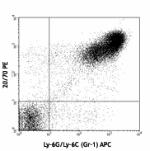
C57BL/6 bone marrow cells stained with 20/70 PE and Ly-6G/Ly... -
Purified anti-mouse CD88 (C5aR)

C57BL/6 mouse bone marrow granulocytes stained with Ly-6G/Ly... -
LEAF™ Purified anti-mouse CD88 (C5aR)
-
Biotin anti-mouse CD88 (C5aR)
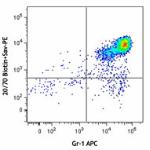
C57BL/6 mouse bone marrow cells were stained with Gr-1 APC a... 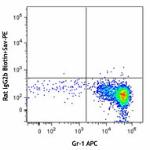
-
APC anti-mouse CD88 (C5aR)

C57BL/6 mouse bone marrow cells were stained with Ly-6G/Ly-6... 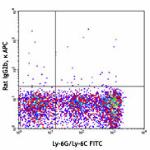
-
PE/Cyanine7 anti-mouse CD88 (C5aR)

C57BL/6 mouse bone marrow cells were stained with anti-mouse... -
PerCP/Cyanine5.5 anti-mouse CD88 (C5aR)

C57BL/6 mouse bone marrow cells were stained with Ly-6G/Ly-6... -
Ultra-LEAF™ Purified anti-mouse CD88 (C5aR)

C57BL/6 mouse bone marrow granulocytes stained with Ly-6G/Ly... -
TotalSeq™-A1042 anti-mouse CD88 (C5aR)
-
TotalSeq™-C1042 anti-mouse CD88 (C5aR) Antibody
-
TotalSeq™-B1042 anti-mouse CD88 (C5aR)
 Login / Register
Login / Register 





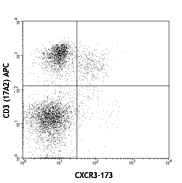

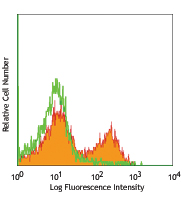




Follow Us